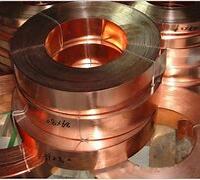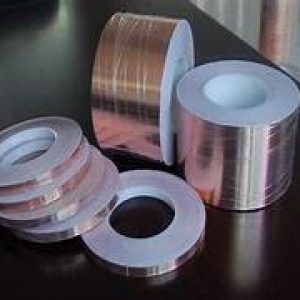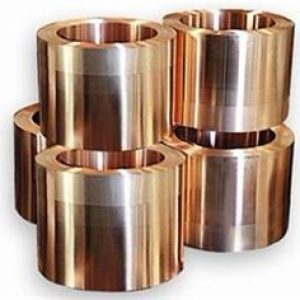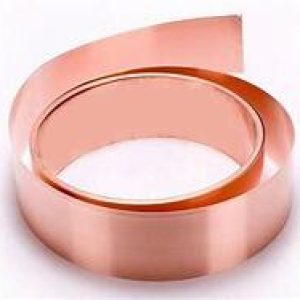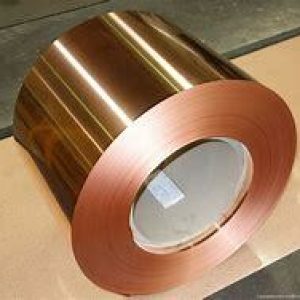Overview of Brass, red copper, copper strip
Copper strip refers to thin, flat, and flexible sheets or strips made from pure copper or copper alloys. Known for their excellent electrical conductivity, thermal conductivity, formability, and resistance to corrosion, copper strips are widely utilized in applications where these properties are of paramount importance. The thickness of copper strips can vary significantly, usually ranging from a few millimeters down to extremely thin foils, while widths can be tailored to suit specific application requirements. Copper strips are commonly manufactured through rolling processes, starting from copper ingots or thicker sheets and progressively reducing their thickness.
Features of Brass, red copper, copper strip
-
High Conductivity: Like copper rods, copper strips offer excellent electrical and thermal conductivity, making them ideal for electrical and electronic components.
-
Formability: Copper strips can be easily bent, folded, or shaped without cracking, which is crucial for complex manufacturing processes.
-
Corrosion Resistance: Copper naturally forms a protective patina that inhibits further corrosion, ensuring its longevity in various environments.
-
Wide Range of Alloys Available: Copper can be combined with other metals to create strips with enhanced properties, such as increased strength, wear-resistance, or specialized thermal and electrical characteristics.
-
Flexibility: The thin and flexible nature of copper strips allows them to conform to curved surfaces or tight spaces, useful in wiring harnesses and compact electronic devices.
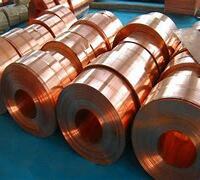
(Brass, red copper, copper strip)
Parameters of Brass, red copper, copper strip
The brass parameter refers to the proportion of copper in a solution of brass or brass alloys, while the red copper parameter refers to the ratio of copper to red copper (CuR) in the same solution.
In general, brass has a higher Cu content than red copper, which means that for every unit weight of brass, there is more Cu than in red copper. This makes brass more ductile and malleable than red copper, but it also makes it more prone to corrosion.
To determine the brass parameter for a given alloy, you would need to know the initial concentration of both copper and red copper in the solution, as well as any additional factors that may affect the behavior of the alloy, such as temperature, pressure, or composition.
It’s worth noting that these parameters can vary depending on the specific type of brass or brass alloy being studied, so it’s important to consult relevant literature and experimental data to ensure accurate and reliable results.
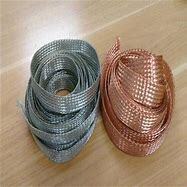
(Brass, red copper, copper strip)
Applications of Brass, red copper, copper strip
-
Electronics Manufacturing: Copper strips are used in printed circuit boards (PCBs), connectors, transformers, and inductor coils due to their high conductivity and ease of processing.
-
Automotive Industry: They are integral to vehicle wiring harnesses, battery terminals, and various electrical components where flexibility and conductivity are required.
-
Building and Construction: Copper strips are used in roofing, flashing, and electrical grounding systems due to their durability and corrosion-resistant properties.
-
HVAC Systems: As part of heat exchangers, evaporators, and condenser coils, copper strips facilitate efficient heat transfer.
-
Telecommunications: Copper strips are found in cable shielding, providing electromagnetic interference (EMI) protection.
Company Profile
Copper Channel is a trusted global metal material supplier & manufacturer with over 12-year-experience in providing super high-quality copper products and relatives products.
The company has a professional technical department and Quality Supervision Department, a well-equipped laboratory, and equipped with advanced testing equipment and after-sales customer service center.
If you are looking for high-quality copper materials and relative products, please feel free to contact us or click on the needed products to send an inquiry.
Payment Methods
L/C, T/T, Western Union, Paypal, Credit Card etc.
Shipment
It could be shipped by sea, by air, or by reveal ASAP as soon as repayment receipt.
FAQs of Brass, red copper, copper strip
Q: What are the standard thicknesses for Brass, red copper, copper strip?
A: Brass, red copper, copper strip can be found in a wide range of thicknesses, typically starting from around 0.1mm up to a few millimeters, depending on the application.
Q: Can Brass, red copper, copper strip be insulated or coated?
A: Yes, Brass, red copper, copper strip can be insulated with materials like PVC, polyethylene, or varnish to protect against environmental factors or to enhance electrical insulation properties.
Q: Is Brass, red copper, copper strip suitable for outdoor use?
A: Absolutely, copper’s inherent corrosion resistance makes it suitable for outdoor applications where exposure to weather conditions is inevitable.
Q: How does Brass, red copper, copper strip compare to copper wires in terms of conductivity?
A: Brass, red copper, copper strip generally has the same level of conductivity as copper wire of the same purity, but their larger surface area can allow for more effective heat dissipation in certain applications.
Q: Are there any specific cleaning or maintenance requirements for Brass, red copper, copper strip?
A: Brass, red copper, copper strip requires minimal maintenance. For cleaning, mild soap and water or specialized metal cleaners can be used, avoiding abrasive materials that might scratch the surface. Regular inspection for signs of corrosion or damage is recommended for critical applications.

(Brass, red copper, copper strip)
